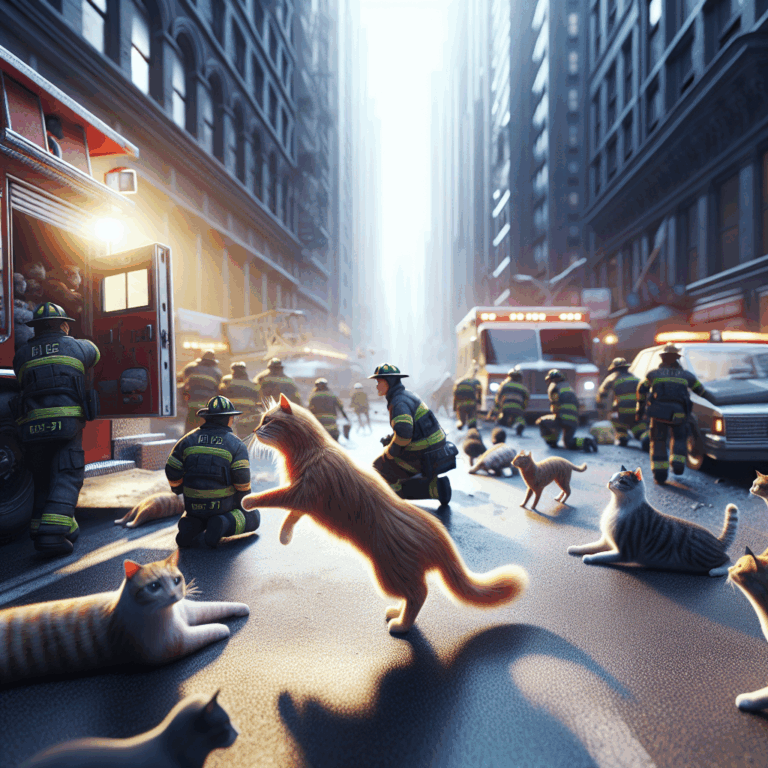The Feline First Responders: How Cats Are Saving Lives in Unimaginable Ways
- 21 Comments
In a world where companionship and loyalty are often attributed to man’s best friend, cats, too, are stepping into the spotlight as unexpected heroes in emergency situations. While their reputation often leans towards aloofness, recent studies and heartwarming tales from around the globe reveal a fascinating new narrative—cats as life-savers.
One of the most striking stories involves a domestic shorthair named Cleo, residing in a quiet suburb of Chicago. Cleo’s owner, an elderly woman living alone, had a medical emergency one evening. The woman, unable to reach her phone, was found unconscious on the floor. Cleo, known for her keen intuition and strong bond with her owner, sensed something was amiss and took action. In a remarkable display of intelligence and empathy, Cleo continuously knocked over items and meowed loudly until neighbors, alerted by the commotion, came to check on the situation. Their timely intervention, prompted by Cleo’s persistent behavior, led to the woman receiving the urgent medical care she needed.
Such instances are not isolated. Across the pond in England, a family’s beloved feline, Smokey, became a local celebrity when she alerted her owners to a dangerous gas leak. The family’s accounts detail how Smokey, usually an indoor cat, incessantly pawed at the windows and doors, refusing to stay inside. This unusual behavior prompted the family to investigate, leading them to discover a gas leak that could have resulted in a catastrophe. Smokey’s actions undoubtedly averted a disaster, earning her the affectionate title of the ‘gas-detecting cat’ among the neighborhood.
Experts suggest that cats’ acute sensory perceptions, particularly their heightened sense of smell and hearing, play a crucial role in these life-saving scenarios. A cat’s ability to detect subtle changes in the environment, whether it be the faint scent of gas or alterations in a human’s physical state, underscores their potential as natural detectors of danger.
Moreover, the bond between cats and their humans is a significant factor contributing to these heroic acts. While cats are often portrayed as solitary creatures, they form deep, emotional connections with their humans. This bond can be particularly evident in moments of distress, where cats, driven by loyalty and affection, act instinctively to protect their loved ones.
Animal behaviorists are taking note of these events, exploring the possibility of training cats as part of emergency response teams. While the idea remains in its infancy, the potential for cats to serve as companions to the elderly, individuals with disabilities, or those at risk of medical emergencies is being seriously considered.
The tales of Cleo, Smokey, and countless other cats around the world highlight an intriguing aspect of feline behavior that challenges traditional perceptions. As more stories of feline heroics emerge, it becomes clear that these animals are more than just pets; they are companions capable of extraordinary acts of bravery and devotion.
As society continues to uncover the remarkable capabilities of cats, it is becoming increasingly evident that these creatures hold an essential, albeit unassuming, role in our lives. The narrative of the feline first responder serves as a testament to the profound impact cats can have, not only as cherished companions but as lifesavers in our communities.

In a world where companionship and loyalty are often attributed to man’s best friend, cats, too, are stepping into the spotlight as unexpected heroes in emergency situations. While their reputation often leans towards aloofness, recent studies and heartwarming tales from around the globe reveal a fascinating new narrative—cats as life-savers.
One of the most striking stories involves a domestic shorthair named Cleo, residing in a quiet suburb of Chicago. Cleo’s owner, an elderly woman living alone, had a medical emergency one evening. The woman, unable to reach her phone, was found unconscious on the floor. Cleo, known for her keen intuition and strong bond with her owner, sensed something was amiss and took action. In a remarkable display of intelligence and empathy, Cleo continuously knocked over items and meowed loudly until neighbors, alerted by the commotion, came to check on the situation. Their timely intervention, prompted by Cleo’s persistent behavior, led to the woman receiving the urgent medical care she needed.
Such instances are not isolated. Across the pond in England, a family’s beloved feline, Smokey, became a local celebrity when she alerted her owners to a dangerous gas leak. The family’s accounts detail how Smokey, usually an indoor cat, incessantly pawed at the windows and doors, refusing to stay inside. This unusual behavior prompted the family to investigate, leading them to discover a gas leak that could have resulted in a catastrophe. Smokey’s actions undoubtedly averted a disaster, earning her the affectionate title of the ‘gas-detecting cat’ among the neighborhood.
Experts suggest that cats’ acute sensory perceptions, particularly their heightened sense of smell and hearing, play a crucial role in these life-saving scenarios. A cat’s ability to detect subtle changes in the environment, whether it be the faint scent of gas or alterations in a human’s physical state, underscores their potential as natural detectors of danger.
Moreover, the bond between cats and their humans is a significant factor contributing to these heroic acts. While cats are often portrayed as solitary creatures, they form deep, emotional connections with their humans. This bond can be particularly evident in moments of distress, where cats, driven by loyalty and affection, act instinctively to protect their loved ones.
Animal behaviorists are taking note of these events, exploring the possibility of training cats as part of emergency response teams. While the idea remains in its infancy, the potential for cats to serve as companions to the elderly, individuals with disabilities, or those at risk of medical emergencies is being seriously considered.
The tales of Cleo, Smokey, and countless other cats around the world highlight an intriguing aspect of feline behavior that challenges traditional perceptions. As more stories of feline heroics emerge, it becomes clear that these animals are more than just pets; they are companions capable of extraordinary acts of bravery and devotion.
As society continues to uncover the remarkable capabilities of cats, it is becoming increasingly evident that these creatures hold an essential, albeit unassuming, role in our lives. The narrative of the feline first responder serves as a testament to the profound impact cats can have, not only as cherished companions but as lifesavers in our communities.



21 thoughts on “The Feline First Responders: How Cats Are Saving Lives in Unimaginable Ways”
While the stories of cats acting heroically are compelling, the idea of training them as emergency responders seems impractical given their independent nature.
It’s fascinating to see how cats’ unique qualities, such as their acute senses and strong bonds with humans, are being explored in new ways. While training them as emergency responders presents challenges, the potential benefits and insights we could gain from understanding their instincts and behaviors are certainly worth considering.
Indeed, the exploration of cats’ instincts and behaviors as potential emergency responders is quite promising. Their unique qualities could offer valuable insights and benefits, making this a worthwhile area for further research and consideration.
While the idea of cats as emergency responders is intriguing, it’s essential to critically assess their reliability and consistency in life-threatening situations. Unlike trained service animals, cats’ responses can be unpredictable, and their effectiveness as responders might vary significantly. More rigorous research is needed to determine the feasibility of this concept before considering them a dependable option in emergencies.
You’ve raised an important point about the unpredictability of cats in emergency situations. While there have been anecdotal accounts of cats acting to alert owners to danger, these instances may not be consistent enough to rely on universally. The idea of cats as emergency responders is still in its early stages and requires more comprehensive research to understand their potential fully. Comparing them to trained service animals highlights the need for a structured approach to see if and how cats could fit into this role. It’s crucial that any future initiatives take into account the variability in individual cats’ behavior and responses.
While the stories of heroic cats are captivating, it’s crucial to consider the rarity of such events and not overstate their capabilities in life-saving situations.
It’s heartwarming to learn about the incredible ways cats are stepping up as unexpected heroes in emergency situations.
It’s indeed interesting to see how cats are being recognized for their roles in emergency situations. The examples of Cleo and Smokey illustrate the potential cats have as intuitive and responsive companions. Their heightened senses and the bond they share with their human families seem to play a crucial role in their ability to act during crises. This emerging narrative sheds new light on the depth of relationships between cats and humans, challenging some of the traditional views about feline behavior. It’s a topic that invites further exploration and understanding.
It’s fascinating to see how cats are stepping into the spotlight as emergency responders. The stories of Cleo and Smokey indeed highlight their intuitive nature and the strong bonds they form with humans. This emerging perspective certainly opens up new avenues for exploring the depth and complexity of feline behavior.
While the stories are heartwarming, it’s crucial to remember that cats’ actions in emergencies are often fortunate coincidences rather than consistent, reliable responses.
This article wonderfully highlights the incredible abilities and unique roles cats can play in emergency situations, showcasing their importance in our lives.
This article wonderfully highlights the surprising and admirable capabilities of cats in emergency situations.
While the post highlights remarkable stories of feline heroics, it may overstate the frequency and practicality of cats as reliable emergency responders compared to trained professionals.
What an incredible insight into the life-saving abilities and roles cats can play in our lives!
It’s incredible to learn about the unique ways cats are making a difference in emergency situations!
Absolutely, it’s fascinating to see cats demonstrating such remarkable abilities and forming deep connections with their humans. Their unique skills truly shine in unexpected ways.
It’s truly intriguing how cats are stepping up in unexpected situations. Their ability to connect with and protect their humans showcases a side of them that many might not have considered before.
It’s inspiring to learn about the incredible ways cats are stepping up as unexpected heroes in emergency situations.
While the stories are fascinating, it’s important to remember that cats acting as first responders is more anecdotal than evidence-based.
It’s true that these stories are largely anecdotal, but they do highlight the intriguing capabilities of cats and their potential in unexpected roles. Exploring and understanding these behaviors can be an exciting area for further study and consideration.
These stories indeed provide fascinating insights into the potential roles cats can play in our lives. Exploring their behaviors further could lead to exciting discoveries in the field of animal behavior and emergency response.